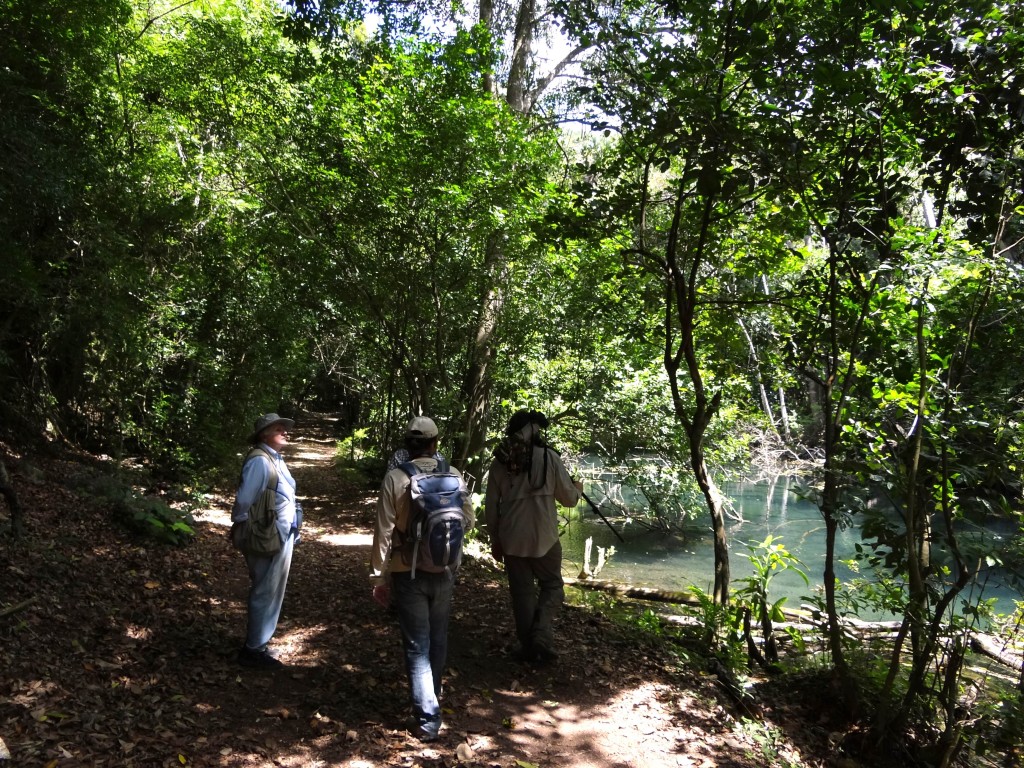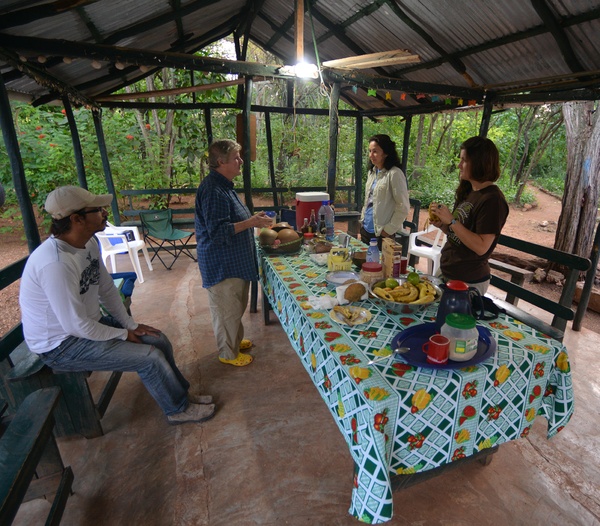Rabo de Gato and Puerto Escondido
Located on the north slope of the Sierra de Bahoruco, the Puerto Escondido area and the Rabo de Gato trail contain some of the premier birding walks in the Dominican Republic. This is one of the “must-see” stops for serious birdwatchers visiting the country. All but two of the 31 bird species endemic to Hispaniola may be found in the Sierra de Bahoruco, and the north slope is a great place to start. A tour of the north slope of the Bahoruco mountains begins at the small town of Puerto Escondido and follows a series of stops described here and in our account for Zapoten (Site B11).

The area known as Rabo de Gato is an interesting narrow strip of riparian habitat with a surprising mix of birds. Riparian areas and water in general is rare in the limestone-based Sierra de Bahoruco because water tends to seep through the limestone and run underground. As such, we often find many interesting birds congregating around water sources. Beginning from the Villa Barrancolí campground just outside of Puerto Escondido, the fairly level trail at Rabo de Gato can be walked in an hour or two without difficulty. Both the Broad-billed and Narrow-billed todies occur here, as well as Hispaniolan Lizard-Cuckoo, Antillean Piculet, Hispaniolan Trogon, Flat-billed Vireo, White-necked Crow, Hispaniolan Oriole, Antillean Euphonia, and the Bay-breasted Cuckoo.
La Placa, Piculet Road, and Los Naranjos are all within a new refuge, the 17,400 hec Loma Charco Azul Biological Reserve (also known as La Placa), that was created primarily to protect threatened birds of the dry and transitional forests. Of particular note in this area are such species as the Bay-breasted Cuckoo, Flat-billed Vireo, Hispaniolan Parrot, and Least Pauraque, as well as up to 30 species of over-wintering Neotropical migratory bird species.

Birding Areas
Rabo de Gato: The fairly level trail at can be walked in an hour or two. Look for the Broad-billed Tody and the Narrow-billed Tody, which seldom co-occur together, but do in a narrow band of sympatry and in certain montane valleys. The Hispaniolan Lizard-Cuckoo, Antillean Piculet, and Hispaniolan Oriole are common, and the Antillean Euphonia may be seen if you keep a sharp ear out and look high in the trees. This is one of the lowest elevation sites for the Hispaniolan Trogon, but also one of the highest elevation sites for the Flat-billed Vireo. You may see the White-necked Crow almost anywhere here, but if you do not find the crows on the trail then return to the dam in the early morning or late afternoon when the birds may be more conspicuous. The very scarce Bay-breasted Cuckoo has been reported here, but if you miss it, it is more likely to be found further down the road towards La Placa.

Point A: La Placa – About 10 km (6.2 miles) beyond the Puerto Escondido T-intersection, you will enter an area of extensive dry broadleaf forest. Here watch for a prominent park sign on your right. You will then see a small road on the right which soon becomes impassable. This is a reliable spot for the Bay-breasted Cuckoo and Flat-billed Vireo. Explore the nearby woods for other dry forest specialists such as the Antillean Piculet. This corner, and the first 100 m of the side road, is a good place to try for night birds. At dawn and dusk it is also one of the best places in the country to see or at least hear the Least Pauraque and Hispaniolan Nightjar; the Northern Potoo will often respond to playback and have been seen here.
Point B: Piculet Road – La Placa is generally known as the beginning of the habitat which seems to be favored by the Bay-breasted Cuckoo. The main indicator is the change from dry-thorn forest to dry broadleaf forest, and the presence of larger trees. Several stops should be made along this road after leaving La Placa. You may want to try the use of playback, but please limit excessive playing of calls. One often productive stop is about 2 km (1.2 miles) beyond La Placa; look for a small lane leading off to the left. This can also be a good place for the Antillean Piculet, Flat-billed Vireo, and Olive-throated Parakeet.
Point C: Los Naranjos – Continue up the road another 2 km (1.2 miles). As the road conditions become rockier, look for several tall trees which stand above the forest. One is a ceiba tree, and its bare branches may be a good place to look for warblers. Just a few meters beyond is the area known as Los Naranjos. It formerly was recognized by a large cleared area on the left hand side, but this is now almost completely overgrown. This area has traditionally provided the most dependable sightings of the Bay-breasted Cuckoo. However, the range of this bird continues for several more kilometers as the road becomes extremely rocky in the cleared river bed.
Target species include White- winged Dove, Key West Quail- Dove, White-fronted Quail- Dove, Olive- throated Parakeet, Bay- breasted Cuckoo, Ashy- faced Owl, Burrowing Owl, Antillean Nighthawk, Least Pauraque, Hispaniolan Nightjar, Northern Potoo, Hispaniolan Trogon, Narrow- billed Tody, Belted Kingfisher, Flat- billed Vireo, White- necked Crow, Louisiana Waterthrush, Antillean Euphonia
From Barahona take the main road north toward Santo Domingo until reaching a major intersection and the road to Cabral, Duvergé, and Jimaní. Turn left and continue to Duvergé (about one hour driving time). In Duvergé look for signs for a left turn to Puerto Escondido; this sign may be missing, but the turn is the fifth left after the gas station in town. Follow this road southward as it leaves town and soon becomes dirt. You will follow a small river bottom, and then steadily climb along an aqueduct through dry and dusty hills until reaching the small village of Puerto Escondido.
The National Park house is on the right as you enter the village. Stop here to get a ticket for the park.
Continue straight through town until reaching a T-intersection. To reach Rabo de Gato turn left at this T-intersection and go past a chain-link fence surrounding the dam buildings. You will then turn right, go down and then up a shallow dip in the road, cross a canal, and take the next right at a sign for Rabo de Gato. Continue straight past a heavy fence on the left where you can then park, or you may continue driving up a small hill and park at its top.
To arrive at La Placa, Piculet Road, and Los Naranjos return to the T-intersection in Puerto Escondido. Here you will take a right if coming from Duverge (but you would go straight if coming from Rabo de Gato). You may see a sign at this corner for Aquacate, which is further along this same road. Upon leaving the T-intersection you will pass by a military guard post (occasionally occupied) on the right, and then continue through the valley, which here is dominated by large avocado plantations on the left. As this is now the only road in the area you can not go wrong.
- Entrance fee: Dominicans $RD 20, Foreigners $RD 50
Villa Barrancolí’s close proximity to the Sierra de Bahoruco National Park makes it an ideal base camp for exploring the northern slope of the Sierra. One can begin by taking the Rabo de Gato trail, a 1-2 hour walk (depending on how good the birdwatching is!) starting at Villa Barrancolí.
The trail leads into riparian woods with a variety of plants and large trees. Those interested in plants, butterflies and birds will enjoy this habitat. All but two of the 32 bird species endemic to Hispaniola may be found in the Sierra de Bahoruco.

Villa Barrancolí is also at the beginning of the international highway (4×4 necessary), leading to Aguacate on the Haitian border and to Zapotén’s cloud forest. The road then continues on to Pedernales.
The Villa is owned and operated by Kate Wallace, who first came to the Dominican Republic as a Peace Corps volunteer in the 90’s. As a former teacher/naturalist with the Massachusetts Audubon Society, she quickly discovered the interesting variety of birds and soon joined a group of birders exploring the wild areas of the country. Part of her work was developing educational materials in parts of the country close to the national parks in the southwest and, in the process, she came to appreciate the opportunities available to visiting birdwatchers.
After the end of her service with Peace Corps, having fallen in love with the country’s flora and fauna, she decided to stay in the country to continue working with community groups and bird conservation. She began guiding in 1997 and has been active as a guide ever since, operating Tody Tours, which specializes in southwestern Dominican Republic. Kate is also active with the Sociedad Ornitológica de la Hispaniola and the Society for the Conservation and Study of Caribbean Birds.
Villa Barrancolí is equipped with five screened cabins with two beds in each. There is a bath house with hot showers and a common dining area. Meals can be arranged if desired.


Access
From the town of Barahona, take the main road north toward Santo Domingo until reaching a major intersection and the raod to Cabral, Duverge, and Jimani. Turn left and continue to Duverge (about one hour driving time). In Duverge look for signs for a left turn to Puerto Escondido. If you miss the sign, the turn is the fifth left after the gas station in town. Follow this road southward as it leaves town and seeon becomes dirt. Follow a small river bottom, and then steadily climb along an aqueduct through dry and dusty hills until reaching the small village of Puerto Escondido. The National Park house is on the right as you enter the village. Stop here to get a ticket for the park.
Continue straight through town until reaching a T-intersection. To reach Villa Barrancolí, and Rabo de Gato, turn left at the T and go past a chain-link fence surrounding the dam buildings. You will then turn right, cross a canal, and take the next right at a sign for Rabo de Gato. Villa Barrancolí will be on your left.
Visit the website for more information: www.todytours.com/villabarrancoli.html
